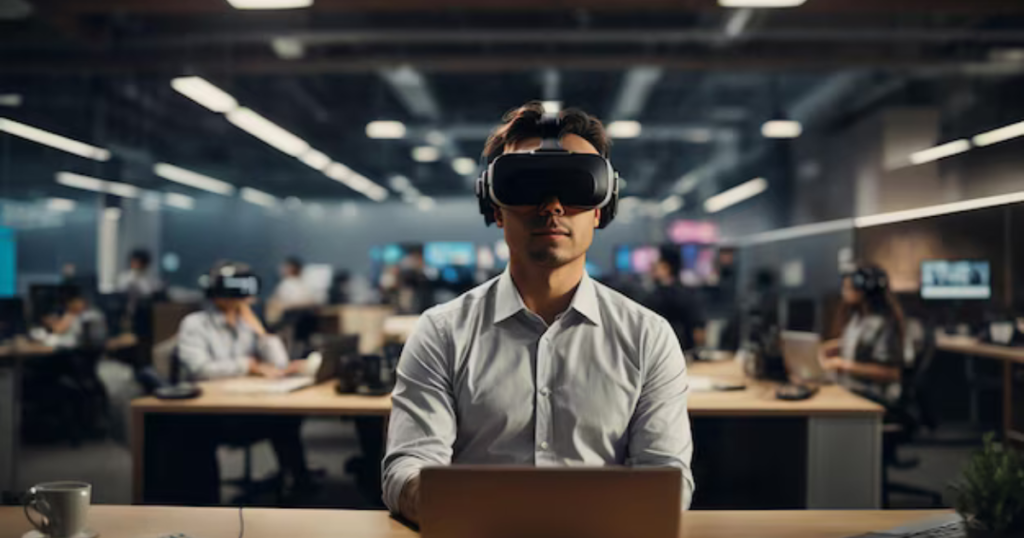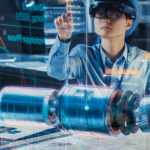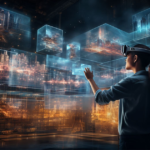Spatial Computing Revolution Technology has continuously evolved, transforming the way humans interact with the digital and physical world. One of the most significant technological advancements of our time is spatial computing—a revolutionary approach that seamlessly blends digital and physical experiences. From augmented reality (AR) and virtual reality (VR) to artificial intelligence (AI) and the Internet of Things (IoT), spatial computing is set to redefine industries and our daily lives.
In this article, we will explore what spatial computing is, why it is considered the future of technology, and how it is poised to change various sectors.
What Is Spatial Computing?
Spatial computing refers to the integration of digital content with the physical world through sensors, AI, and real-time data processing. It enables users to interact with computers in a natural and immersive way, making digital interactions more intuitive and seamless.
Key Technologies Enabling Spatial Computing
- Augmented Reality (AR): Overlays digital content on the real world using devices like smartphones and AR glasses.
- Virtual Reality (VR): Creates fully immersive digital environments that users can interact with through headsets and motion tracking.
- Mixed Reality (MR): Combines elements of AR and VR to create interactive digital-physical experiences.
- Artificial Intelligence (AI): Enhances spatial computing by enabling machines to process spatial data and make intelligent decisions.
- Computer Vision: Allows devices to understand and interpret visual data from the environment.
- Internet of Things (IoT): Connects physical objects to the digital world, enabling seamless interaction.
- 5G and Edge Computing: Enhances data processing speeds, reducing latency and enabling real-time spatial computing applications.
Why Spatial Computing Is the Future of Technology
1. Transforming Human-Computer Interaction
Traditional computing relies on screens, keyboards, and mice. Spatial computing introduces natural interfaces like voice commands, hand gestures, and eye tracking, making technology more intuitive and immersive.
2. Enhancing Real-World Applications
Spatial computing extends beyond entertainment and gaming. It has real-world applications in fields like healthcare, education, manufacturing, and retail, driving productivity and innovation.
3. Revolutionizing Remote Work and Collaboration

With virtual collaboration spaces and holographic meetings, spatial computing allows teams to work together from different locations as if they were in the same room, enhancing remote work experiences.
4. Creating Hyper-Personalized Experiences
Spatial computing, combined with AI, enables businesses to create personalized and adaptive experiences, whether in marketing, e-commerce, or healthcare.
5. Enhancing Smart Cities and Urban Planning
Governments and urban planners can use spatial computing for real-time traffic monitoring, smart infrastructure development, and emergency response planning to make cities more efficient and sustainable.
Industries Transformed by Spatial Computing
1. Healthcare
Spatial computing is revolutionizing medicine by enabling AR-assisted surgeries, remote diagnostics, and medical training using VR simulations.
2. Education
Virtual and augmented reality allow students to explore historical sites, conduct science experiments, and interact with 3D models, making learning more engaging and effective.
3. Retail and E-Commerce
Retailers are adopting virtual try-ons, AR shopping experiences, and AI-powered assistants to provide customers with immersive and personalized shopping experiences.
4. Manufacturing and Industry 4.0
Factories and supply chains benefit from AR-guided assembly, predictive maintenance, and robotic automation, increasing efficiency and reducing errors.
5. Gaming and Entertainment
The gaming industry is a major driver of spatial computing, with VR gaming experiences, interactive environments, and metaverse applications shaping the future of entertainment.
6. Real Estate and Architecture
Architects and real estate developers use AR/VR to create immersive property tours, digital twin models, and smart home integrations, making design and purchasing decisions easier.
Challenges and Considerations in Spatial Computing
1. Privacy and Security Concerns

As spatial computing collects vast amounts of data, ensuring user privacy and data protection is a significant challenge.
2. High Costs of Implementation
The cost of developing and deploying spatial computing technologies can be high, making adoption slower for smaller businesses.
3. Hardware Limitations
Advanced AR/VR devices are still expensive and bulky. Technological advancements are needed to make them more accessible and user-friendly.
4. Ethical and Social Implications
With the integration of digital and physical worlds, there are concerns about addiction, misinformation, and ethical AI usage that need to be addressed.
The Future of Spatial Computing
1. The Rise of the Metaverse
With companies like Meta, Microsoft, and Apple investing heavily in the metaverse, spatial computing will play a crucial role in creating persistent, interconnected digital spaces.
2. AI-Powered Spatial Experiences
AI-driven spatial computing will lead to hyper-intelligent environments, where devices anticipate user needs and adapt in real-time.
3. Seamless Integration with Wearable Technology
Future advancements in smart glasses, haptic feedback devices, and brain-computer interfaces will make spatial computing more immersive and interactive.
4. Mainstream Adoption in Everyday Life
As spatial computing becomes more affordable and accessible, it will be integrated into smart homes, autonomous vehicles, and public infrastructure, making it a part of daily life.
Also Read: What Is The Future Of Blockchain In Healthcare?
Conclusion
The spatial computing revolution is reshaping the way humans interact with technology, offering a more intuitive, immersive, and intelligent future. With applications spanning across industries, from healthcare to gaming and urban planning, spatial computing has the potential to drive significant technological advancements.
While challenges such as privacy concerns, hardware limitations, and ethical considerations need to be addressed, the benefits of spatial computing far outweigh the obstacles. As technology continues to evolve, spatial computing will become an integral part of our daily lives, paving the way for a smarter, more connected world.
FAQs
1. What is the difference between spatial computing and traditional computing?
Traditional computing relies on screens, keyboards, and input devices, whereas spatial computing enables natural interactions through AR, VR, AI, and gesture-based controls.
2. How does spatial computing impact businesses?
Businesses can use spatial computing for better customer engagement, virtual collaboration, immersive marketing experiences, and automation, leading to increased efficiency and innovation.
3. Is spatial computing the same as the metaverse?
While the metaverse is a concept that involves interconnected virtual worlds, spatial computing is the underlying technology that enables immersive digital-physical interactions.
4. What are the challenges in implementing spatial computing?
Challenges include high costs, privacy concerns, hardware limitations, and ethical implications that need to be addressed for widespread adoption.
5. Will spatial computing replace traditional screens?
While spatial computing will enhance and complement traditional screens, it is unlikely to replace them entirely. Instead, it will offer alternative ways to interact with digital content.





